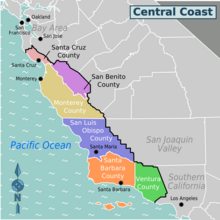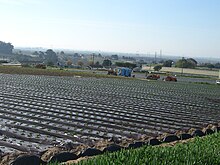Bromomethane, commonly known as methyl bromide, is an organobromine compound with formula CH3Br. This colorless, odorless, nonflammable gas is produced both industrially and biologically. It is a recognized ozone-depleting chemical. It was used extensively as a pesticide until being phased out by most countries in the early 2000s. From the chemistry perspective, it is one of the halomethanes.

In organic chemistry, chlorpyrifos (CPS), also known as chlorpyrifos ethyl, is an organophosphate pesticide that has been used on crops, animals, and buildings, and in other settings, to kill several pests, including insects and worms. It acts on the nervous systems of insects by inhibiting the acetylcholinesterase enzyme. Chlorpyrifos was patented in 1966 by Dow Chemical Company.

Sulfuryl fluoride (also spelled sulphuryl fluoride) is an inorganic compound with the formula SO2F2. It is an easily condensed gas and has properties more similar to sulfur hexafluoride than sulfuryl chloride, being resistant to hydrolysis even up to 150 °C. It is neurotoxic and a potent greenhouse gas, but is widely used as a fumigant insecticide to control termites.
Chloropicrin, also known as PS and nitrochloroform, is a chemical compound currently used as a broad-spectrum antimicrobial, fungicide, herbicide, insecticide, and nematicide. It was used as a poison gas in World War I. Its chemical structural formula is Cl3C−NO2.
Iodomethane, also called methyl iodide, and commonly abbreviated "MeI", is the chemical compound with the formula CH3I. It is a dense, colorless, volatile liquid. In terms of chemical structure, it is related to methane by replacement of one hydrogen atom by an atom of iodine. It is naturally emitted by rice plantations in small amounts. It is also produced in vast quantities estimated to be greater than 214,000 tons annually by algae and kelp in the world's temperate oceans, and in lesser amounts on land by terrestrial fungi and bacteria. It is used in organic synthesis as a source of methyl groups.

Breast Cancer Action (BCAction) is a U.S.-based grassroots education and activist organization driven by and supporting people living with breast cancer. It was founded in 1990 by Elenore Pred, Susan Claymon, Belle Shayer, and Linda Reyes. Based in San Francisco, BCAction is known for understanding breast cancer not as an individual crisis, but a public health emergency, and for their commitment to social justice. The organization's mission is to achieve health justice for all women at risk of and living with breast cancer. BCAction is known for its Think Before You Pink campaign, launched in 2002, which encourages consumers to ask critical questions before buying pink ribbon products and holds corporations accountable for pinkwashing.

1,3-Dichloropropene, sold under diverse trade names, is an organochlorine compound with the formula C3H4Cl2. It is a colorless liquid with a sweet smell. It is feebly soluble in water and evaporates easily. It is used mainly in farming as a pesticide, specifically as a preplant fumigant and nematicide. It is widely used in the US and other countries, but is banned in 34 countries.

Organophosphate poisoning is poisoning due to organophosphates (OPs). Organophosphates are used as insecticides, medications, and nerve agents. Symptoms include increased saliva and tear production, diarrhea, vomiting, small pupils, sweating, muscle tremors, and confusion. While onset of symptoms is often within minutes to hours, some symptoms can take weeks to appear. Symptoms can last for days to weeks.

The Food Quality Protection Act (FQPA), or H.R.1627, was passed unanimously by Congress in 1996 and was signed into law by President Bill Clinton on August 3, 1996. The FQPA standardized the way the Environmental Protection Agency (EPA) would manage the use of pesticides and amended the Federal Insecticide, Fungicide, and Rodenticide Act and the Federal Food Drug and Cosmetic Act. It mandated a health-based standard for pesticides used in foods, provided special protections for babies and infants, streamlined the approval of safe pesticides, established incentives for the creation of safer pesticides, and required that pesticide registrations remain current.

Pesticide drift, also known as spray drift refers to the unintentional diffusion of pesticides toward nontarget species. It is one of the most negative effects of pesticide application. Drift can damage human health, environment, and crops. Together with runoff and leaching, drift is a mechanism for agricultural pollution. Some drift results from contamination of sprayer tanks.

Pesticides in the United States are used predominantly by the agricultural sector, but approximately a quarter of them are used in houses, yards, parks, golf courses, and swimming pools.

Sentinel Event Notification System for Occupational Risks (SENSOR)-Pesticides is a U.S. state-based surveillance program that monitors pesticide-related illness and injury. It is administered by the National Institute for Occupational Safety and Health (NIOSH), twelve state health agencies participate. NIOSH provides technical support to all participating states. It also provides funding to some states, in conjunction with the US Environmental Protection Agency.

The Office of Environmental Health Hazard Assessment, commonly referred to as OEHHA, is a specialized department within the cabinet-level California Environmental Protection Agency (CalEPA) with responsibility for evaluating health risks from environmental chemical contaminants.

The Migrant and Seasonal Agricultural Worker Protection Act, codified at 29 U.S.C. §§ 1801-1872, is the main federal law that protects farm workers in the United States and repealed and replaced the Farm Labor Contractor Registration Act.

The California Department of Pesticide Regulation, also known as DPR or CDPR, is one of six boards and departments of the California Environmental Protection Agency (Cal/EPA).

Health effects of pesticides may be acute or delayed in those who are exposed. Acute effects can include pesticide poisoning, which may be a medical emergency. Strong evidence exists for other, long-term negative health outcomes from pesticide exposure including birth defects, fetal death, neurodevelopmental disorder, cancer, and neurologic illness including Parkinson's disease. Toxicity of pesticides depend on the type of chemical, route of exposure, dosage, and timing of exposure.

1,2,3-Trichloropropane (TCP) is an organic compound with the formula CHCl(CH2Cl)2. It is a colorless liquid that is used as a solvent and in other specialty applications.

Pesticide regulation in the United States is primarily a responsibility of the Environmental Protection Agency (EPA). In America, it was not till the 1950s that pesticides were regulated in terms of their safety. The Pesticides Control Amendment (PCA) of 1954 was the first time Congress passed guidance regarding the establishment of safe limits for pesticide residues on food. It authorized the Food and Drug Administration (FDA) to ban pesticides they determined to be unsafe if they were sprayed directly on food. The Food Additives Amendment, which included the Delaney Clause, prohibited the pesticide residues from any carcinogenic pesticides in processed food. In 1959, pesticides were required to be registered.
Pesticide incidents in the San Joaquin Valley is a topic covering the justice and health issues of people living in the San Joaquin Valley resulting from the use of pesticides in the region. Pesticide use in the San Joaquin Valley began in the 1880s when certain insects were known to be causing harm in the region, much of whose economy is still based on the successful agriculture and farming of many different kinds of crops. Pesticides illnesses were reported sporadically during that time frame, but was not focused as a major issue until the post World War II agricultural boom in the late 1940s when pesticide poisonings became more widely publicized. Though Rachel Carson's Silent Spring and the use of chemicals in weapons during the Vietnam War led the federal government to pass restrictions on pesticide use, residents, primarily of low-income, have struggled with health impacts of pesticide use due to persistent over-spraying by agriculture companies working for profit.

Farmworkers in the United States have unique demographics, wages, working conditions, organizing, and environmental aspects. According to The National Institute for Occupational Safety & Health in Agricultural Safety, approximately 2,112,626 full-time workers were employed in production agriculture in the US in 2019 and approximately 1.4 to 2.1 million hired crop workers are employed annually on crop farms in the US. A study by the USDA found the average age of a farmworker to be 33. In 2017, the Department of Labor and Statistics found the median wage to be $23,730 a year, or $11.42 per hour.






















